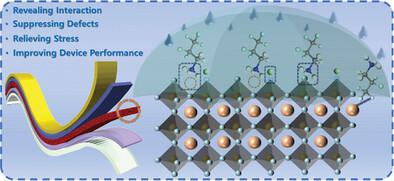当前位置:
X-MOL 学术
›
Adv. Funct. Mater.
›
论文详情
Our official English website, www.x-mol.net, welcomes your feedback! (Note: you will need to create a separate account there.)
Revealing Interaction of Fluorinated Propylamine Hydrochloride with Precursor and Defect States of Perovskite Films Toward Efficient Flexible Solar Cells
Advanced Functional Materials ( IF 19.0 ) Pub Date : 2024-05-13 , DOI: 10.1002/adfm.202405078 Shuguang Cao 1, 2 , Zhuoneng Bi 2 , Tongjun Zheng 1, 2 , Shizi Luo 1, 2 , Lavrenty G. Gutsev 3, 4 , Bala R. Ramachandran 4 , Victoria V. Ozerova 3 , Nikita A. Emelianov 3 , Nikita A. Slesarenko 3 , Yupeng Zheng 2 , Biniyam Zemene Taye 1, 2, 5 , Gennady L. Gutsev 6 , Sergey M. Aldoshin 3 , Pavel A. Troshin 3, 7 , Xueqing Xu 1, 2
Advanced Functional Materials ( IF 19.0 ) Pub Date : 2024-05-13 , DOI: 10.1002/adfm.202405078 Shuguang Cao 1, 2 , Zhuoneng Bi 2 , Tongjun Zheng 1, 2 , Shizi Luo 1, 2 , Lavrenty G. Gutsev 3, 4 , Bala R. Ramachandran 4 , Victoria V. Ozerova 3 , Nikita A. Emelianov 3 , Nikita A. Slesarenko 3 , Yupeng Zheng 2 , Biniyam Zemene Taye 1, 2, 5 , Gennady L. Gutsev 6 , Sergey M. Aldoshin 3 , Pavel A. Troshin 3, 7 , Xueqing Xu 1, 2
Affiliation

|
The trap state at the surfaces and grain boundaries of perovskite is one of the major obstacles to the further commercialization of flexible perovskite solar cells (FPSCs). Herein, two innovative multifunctional fluorinated propylamine salt 2,2,3,3,3‐pentafluoropropylamine hydrochloride (PFPACl) and 3,3,3‐triflupropylamine hydrochloride (TFPACl) are in situ introduced onto the photo absorbing layer to improve the performance of the FPSCs. The nuclear magnetic resonance (NMR) spectroscopy indicates strong interactions of both PFPACl and TFPACl with the perovskite precursor components. For the first time, the structures of the supramolecular complexes formed by two additives with FAI are deduced from NOESY NMR data, thus pointing to the importance of the preorganization of the perovskite components in solution before film casting. The experiments and density functional theory(DFT) calculations reveal that PFPACl is likely dissociated more into the form of R‐NH3 + ‐Cl− due to the higher electronegativity of the fluoroalkyl tail. Therefore, PFPA+ binds more strongly to VFA defects than TFPA+ , and anion Cl− has strong enough interaction with VFAI and uncoordinated Pb2+ , leading to homogeneous coverage of PFPACl on the entire surface of the perovskite films and better energy alignment with the hole transport layer. Consequently, PFPACl‐treated FPSCs achieved a relatively high PCE of 23.59% with excellent mechanical robustness and operational stability.
中文翻译:

揭示氟化丙胺盐酸盐与前体和钙钛矿薄膜缺陷态的相互作用,以实现高效柔性太阳能电池
钙钛矿表面和晶界的陷阱态是柔性钙钛矿太阳能电池(FPSC)进一步商业化的主要障碍之一。在此,将两种创新的多功能氟化丙胺盐2,2,3,3,3-五氟丙胺盐酸盐(PFPACl)和3,3,3-三氟丙胺盐酸盐(TFPACl)原位引入到光吸收层上,以提高光吸收层的性能。 FPSC。核磁共振 (NMR) 光谱表明 PFPACl 和 TFPACl 与钙钛矿前体组分有强烈的相互作用。首次从 NOESY NMR 数据推导出两种添加剂与 FAI 形成的超分子复合物的结构,从而指出了薄膜流延前溶液中钙钛矿组分预组织的重要性。实验和密度泛函理论(DFT)计算表明PFPACl可能更多地解离成R-NH的形式3 + ‐Cl- 由于氟烷基尾部具有较高的电负性。因此,PFPA+ 与 V 的结合更牢固F A 与 TFPA 相比的缺陷+ , 和阴离子 Cl- 与V有足够强的相互作用固定资产投资 和不配位的Pb2+ ,导致 PFPACl 均匀覆盖在钙钛矿薄膜的整个表面上,并与空穴传输层更好的能量对准。因此,经过 PFPACl 处理的 FPSC 实现了 23.59% 的相对较高的 PCE,并具有优异的机械鲁棒性和运行稳定性。
更新日期:2024-05-13
中文翻译:

揭示氟化丙胺盐酸盐与前体和钙钛矿薄膜缺陷态的相互作用,以实现高效柔性太阳能电池
钙钛矿表面和晶界的陷阱态是柔性钙钛矿太阳能电池(FPSC)进一步商业化的主要障碍之一。在此,将两种创新的多功能氟化丙胺盐2,2,3,3,3-五氟丙胺盐酸盐(PFPACl)和3,3,3-三氟丙胺盐酸盐(TFPACl)原位引入到光吸收层上,以提高光吸收层的性能。 FPSC。核磁共振 (NMR) 光谱表明 PFPACl 和 TFPACl 与钙钛矿前体组分有强烈的相互作用。首次从 NOESY NMR 数据推导出两种添加剂与 FAI 形成的超分子复合物的结构,从而指出了薄膜流延前溶液中钙钛矿组分预组织的重要性。实验和密度泛函理论(DFT)计算表明PFPACl可能更多地解离成R-NH的形式
































 京公网安备 11010802027423号
京公网安备 11010802027423号